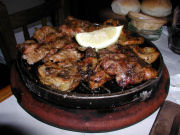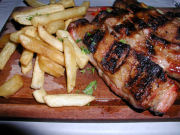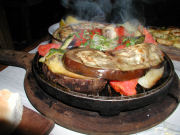Buenos Aires – That seems to be the question on several of my friends’ lips, as I don’t seem to be eating steak four meals a day. There is a myth that beef for breakfast, lunch, second lunch, and dinner is how the porteños eat. And, as a tourist, I have no doubt that has nearly happened to many a visitor, especially if they’re on a “package tour.”
Oh, and yes, four meals a day is common, though I don’t really think of the second lunch as a meal. Assuming I’m following a somewhat typical pattern, learned from my new friends here, desayuno, or breakfast, consists of a cup of coffee or tea and a couple of medialunas, which are bascially skimpy croissants. They come in savory and sweet, i.e., plain or lightly glazed with sugar. Alternatively, and my preference most mornings, a piece of fruit or some juice. The big meal of the day, unless one is headed out for dinner, is generally the almuerzo, often a two or three course lunch. This is the meal at which if one eats out, one digs into the menú del día or menú completo – usually soup followed by a meat course with salad, and sometimes followed by coffee and dessert. Beef is indeed common, though chicken is a very readily available; with pork, fish and other meats being far less common.
“Second lunch”, generally just referred to as lunch, occurs in mid to late afternoon, possibly right after work. It’s a little something to hold you over until dinner – remember, if you’ve been reading along, dinner here often doesn’t occur until sometime between 9 p.m. and midnight. Depending on your later plans this can be as light as yet one more cup of coffee accompanied by facturas, which are a selection of small pastries available in any coffee shop or bakery. It can also be somewhat more substantial – the sandwich often shows up if dinner is going to be quite late. Sandwiches for this meal lean towards very thin slices of white bread with some very thin filling. Crusts removed. Very much like a sort of afternoon tea. Dinner can be anything from a simple pasta or stew at home, which is quite common, pizza, takeout food, or a wide variety of things, much like anywhere else. It’s generally a bit lighter than the almuerzo, unless you’re going out to dinner. In which case, no holds barred, pack it in, I’ve never seen people put away quite so much food (and how do they remain so damnably thin?) meals are the order of the day.
In the evening, my friend Michael and I decided to head into the trendy restaurant neighborhood of Las Cañitas, where I’d been once before to meet another friend for a quick bite and a glass of wine. This area has been getting all the writeups as “the” spot of the moment for the food fashionable. Before settling on a spot, we spent about an hour wandering around and just window-shopping the restaurants. There are indeed a lot of them. The vast majority are the classic parrilla, or Argentine grill – and in the end we settled on one of those. There were also quite a few sushi restaurants; unfortunately for someone who’s quite adventurous in that vein, the choices of fish are salmon, salmon, and/or salmon. I have yet to hear a cogent explanation of why sushi bars here only serve salmon, but they only serve salmon. (We did find one spot that within a listing of several dozen different styles of salmon roll offered one special “redfish” and one of “langoustine” – interestingly not listed in Spanish as langostino.)
There was little else of note, a few attempts at more trendy food, what has been written up as “New York style”, but these spots were empty. It was a Sunday evening, and we were relatively early, having arrived in the area at about 8:30, but with the exception of a few parrillas, most spots had no more than a handful of people in them (some were completely empty). We decided to pick somewhere that looked a little more popular, and found three parrillas on one block that all were jammed with folks. And I do mean jammed – the one we settled on, Las Cholas (an odd one to translate, as the name can be endearing or pejorative depending on who’s using it, basically referring to mestizos, or half-breeds – people of mixed European/Indian heritage – and in this case, plural and feminine) at Arce 306, has two levels with well over 200 seats, and virtually every one of them was occupied. By the way, when we left a couple of hours later, around 11:45, most of the restaurants that we’d seen empty at 8:30 were now quite busy, and there were people on the streets looking for places to eat!
We ended up on the second floor, basically a gravel roof with a plastic tent erected over it. It was dark – you’d need a candle just to find your way to the candle lighting your table. We opted to sit near the open kitchen where at least there was a bit of a glow coming from a few lights there. It was also warmer there. As our eyes adjusted it became clear that we’d stumbled into one of the “in” spots for the 20-something crowd, and over the course of the evening, we were pretty much it in the over 30 world. Oh yes, it’s also a bit on the noisy side. Surprise.
We ordered a bottle of Navarro Correas Cabernet-Merlot-Malbec 2003 (I’d refer you to their website, but it’s under construction and there’s no wine info there). This is a tried and true winery that consistently produces good if not exceptional wines. For 28 pesos ($10), this was the most expensive bottle on the winelist, and a great value.
For an appetizer, I had the mix asarcas (a very strange conjugation of the verb asarse, which means to grill, something I’ll have to ask my spanish teacher about) – note to the squeamish, don’t look – which was listed as a classic grill of chinchulínes, riñónes, & mollejas, or, respectively, intestines, kidneys, & sweetbreads.  What arrived was a quite large sizzling platter of the first two, and a slice of calf’s liver rather than the sweetbreads; as best I could gather, despite the menu, the mixed grill changes depending on what’s available – without notice. Now, before you go “ewwwww” about the intestines… okay, it’s already too late, they’re really very good. I’ve had them before, in Italy (where it’s called pajata) and Uruguay, prepared in similar ways. What you’re getting is the intestine of a very young calf, when it’s had nothing to eat but mother’s milk, which is left inside them. The intestines are grilled or roasted, which sort of turns the milk into a cheese like consistency. In terms of the intestine itself, hey, it’s meat – slightly chewy, slightly crispy when grilled, but it’s meat. The mixed grill was delicious if a little fatty for my tastes, and with a squirt of lemon juice and some salt was a nice reintroduction to this Argentine classic.
What arrived was a quite large sizzling platter of the first two, and a slice of calf’s liver rather than the sweetbreads; as best I could gather, despite the menu, the mixed grill changes depending on what’s available – without notice. Now, before you go “ewwwww” about the intestines… okay, it’s already too late, they’re really very good. I’ve had them before, in Italy (where it’s called pajata) and Uruguay, prepared in similar ways. What you’re getting is the intestine of a very young calf, when it’s had nothing to eat but mother’s milk, which is left inside them. The intestines are grilled or roasted, which sort of turns the milk into a cheese like consistency. In terms of the intestine itself, hey, it’s meat – slightly chewy, slightly crispy when grilled, but it’s meat. The mixed grill was delicious if a little fatty for my tastes, and with a squirt of lemon juice and some salt was a nice reintroduction to this Argentine classic.  Michael tried their tamales norteños which he said had the right texture and were really only missing one thing, flavor.
Michael tried their tamales norteños which he said had the right texture and were really only missing one thing, flavor.
The main courses offered were a variety of different meats, each served with french fries (okay, papas fritas, but they’re french fries). Michael had the chicken breast, I had the pork ribs (pechitos de cerdo) – three quite large ribs with way too much fat and way too little meat on them.  The flavor was just fine, and after the mixed grill I was pretty much full anyway, so I guess the lack of quantity wasn’t a bad thing, but if it had been my only dish I’d have been disappointed. We also shared a platter of grilled vegetables – a really nice selection of potatoes, sweet potatoes, eggplant, tomatoes, mushrooms, zucchini, and onions. The rest of dinner, after the $10 bottle of wine, ran another 52 pesos – roughly $18. Overall, if you’re looking for someplace to hang out with lots of trendy 20-somethings in a noisy, dark environment, and have some decent if not great food, I could unreservedly recommend this spot.
The flavor was just fine, and after the mixed grill I was pretty much full anyway, so I guess the lack of quantity wasn’t a bad thing, but if it had been my only dish I’d have been disappointed. We also shared a platter of grilled vegetables – a really nice selection of potatoes, sweet potatoes, eggplant, tomatoes, mushrooms, zucchini, and onions. The rest of dinner, after the $10 bottle of wine, ran another 52 pesos – roughly $18. Overall, if you’re looking for someplace to hang out with lots of trendy 20-somethings in a noisy, dark environment, and have some decent if not great food, I could unreservedly recommend this spot.
[…] So it wasn’t really that much of a surprise as we wandered Las Cañitas, hoping to cross off one of the recommendations on my list. After the third attempt in the same general vicinity, only to find each of them closed until sometime next week or the week after, we decided to just grab lunch at some place that looked interesting. Within moments, we came upon Bodensee, Ortega y Gasset 1876, a narrow, dimly lit, hole in the wall, advertising German cuisine. I recall having a conversation with the owner back in July, on a night when my friend Michael and I were wandering the streets of Las Cañitas, looking for a decent sushi bar (and somehow ending up at some noisy Gen-X parrilla). The gentleman made concerted efforts to talk us into dining on heaps of roast pork instead of fish on rice. I remember noting that the menu (which is primarily local porteña cuisine) had a list of specials that seemed more in line with the cuisine of Austro-Hungary than Germany. The owner copped to his family being from that area, but felt that German was a better local marketing ploy. […]
Dan recommended this place for its second floor open air dining. My husband and I went early on a Friday night and it was pretty quiet when we got there. It filled up quickly though and since we’re both non-smokers, we were able to enjoy our dinner mostly sans smoke! Their parilla was pretty good but my favorite wa the vegetables grilled on the parilla. Smoky and tender, they melted in my mouth, that is except for the corn which was dried out and chewy. Wait staff was attentive and our server was very nice. We never got the chance to enjoy desert, too full from dinner. Overall not bad though.